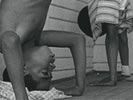Eye For Film >> Movies >> Killer Of Sheep (1977) Film Review
The phrase "Black American cinema in the 1970s" probably conjures up for most people the image of a sharp-suited amoral private eye/drug dealer hustling his way through a teeming, neon-lit urban cityscape – a cinema that was kinetic, confrontational and sometimes subversive but could hardly be described as artistic.
Anyone who’s interested in having such perceptions pleasantly overturned should make a beeline to the BFI for this restored version of Charles Burnett’s little seen 1977 classic – a profound, lyrical and moving film that paints a vivid picture of another world without ever resorting to cliché, makes political points without ever ramming them down your throat and rivals the giants of European and Asian cinema in creating a celebration of the basic decency and dignity of ordinary people.

Made for less than $10,000 over a year’s worth of weekends and using a largely non-professional cast, the film was his graduation work at UCLA – and the examiners probably ran out of plus signs to put after his ‘A’. He’s continued to make films ever since, but paradoxically, Killer Of Sheep - which was never intended to be screened beyond the campus - has acquired a reputation (boosted by one-off screenings and a critics’ award at the Berlin Film Festival in 1981) as his masterpiece, and as one of the great American films of the past four decades.
The print has been restored by UCLA’s Film & Television Archive and after a six-year effort by Milestone, the US distribution company, clearance had been granted on all the music in its eclectic soundtrack. It’s being shown in an extended run by the BFI as part of a season of his work. If there’s any justice, it will cement his reputation as one of the great African-American filmmakers.
It tells the story of Stan (Henry G Sanders), a slaughterhouse worker in the Watts area of Los Angeles (Burnett’s birthplace) and his efforts to provide for his wife (Kaycee Moore) and children (Jack Drummond and Angela Burnett). To do this he takes on extra odd-job work and tries various legal money-making schemes with his friends in the area. The strain of doing so makes him permanently tired, but he is determined to resist the invitations by the local criminals to throw in with them. His wife is supportive, but frustrated by his increasingly withdrawn nature; his children hang out with their friends in the desolate, derelict neighbourhood, where crime is a part of day-to-day life and following their father’s example isn’t always easy.
Those expecting non-stop action, or even a central dramatic turning-point, will be disappointed; this is a film of small, beautifully observed vignettes where small, intimate moments dictate a character’s story arc, not contrived set pieces or polemical dialogue. It’s a non-judgemental, documentary-style take on an area a world away from affluent, white Los Angeles or even the high-rise ghettoes which formed the setting for most blaxploitation films of the period. This is a world of rubble-strewn wastelands, clapboard houses and rutted roads, where the everyday world of the characters seems all-too similar to that of their families from a few generations ago.
This feeling of age-old struggle for dignity and betterment is heightened by the soundtrack; no hi-hat hot-buttered soul here. Earth, Wind and Fire are the only contemporary artists and most of the musical interludes are from an earlier generation - Paul Robeson, Etta James, George Gershwin (even some Rachmaninov) create a cumulative sense of a history of suffering, but also a hard-working dignity and respect for the family that transcends it. Like an original delta blues recording, it is authentically of its time but has the power to speak across continents and generations.
Some of the symbolism is a little overdone (the flocks of sheep milling blindly into the slaughterhouse, which give the film its title, are constantly juxtaposed with shots of Stan and his friends) and the sheer attention to detail will put off those used to cinema that assumes a goldfish-sized attention span.
But it’s never ponderous or wilfully arty; there’s always something going and some of the vignettes are hilarious; Stan and friend’s attempts to transport a car motor back home, or his wife shoo-ing the local gangsters off the porch when they try to inveigle her husband into their schemes, are beautifully written and paced.
There’s a warmth and humanity to this film that recalls Vittorio De Sica or Roberto Rossellini, and the pace and precision of the direction are on a par with Yasujiro Ozu or Satyajit Ray. And it’s refreshing in its depiction of the few white characters encountered; neither racist rednecks or saintly liberals, they’re just ordinary blue-collar folk rubbing along with their neighbours and playing the best game they can after being dealt a pretty poor hand by life.
It’s clear that life for Stan, and all his friends, will always be a hard grind (his day to day routine at the slaughterhouse is presented in unflinching detail; the squeamish and committed vegetarians may want to think twice before seeing this film) but Burnett has faith in the power of small moments and gestures of love to rise above it. The scene where he and his wife dance slowly to Dinah Washington’s This Bitter Earth sums up the film as a whole; slow, meditative and a touch melancholy, but also beautiful, powerful and ultimately uplifting.
Reviewed on: 15 May 2008


















